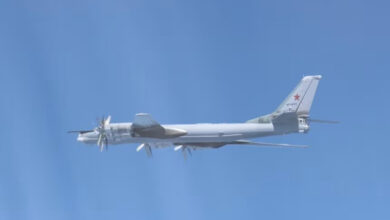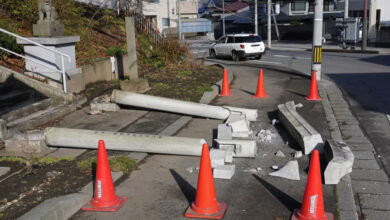
Germany and Japan rose from the ashes of World War II to become global economic powerhouses in a few decades. But how did they achieve this remarkable feat so quickly, and what is the legacy of these parallel economic "miracles" today?
What was the state of both countries after WWII?
Both nations lay in ruins.
A significant proportion of the Japanese population was wiped out during World War II, including an estimated 210,000 people in the atomic bombings of Hiroshima and Nagasaki alone.
Germany had also lost millions of soldiers and civilians, with hundreds of thousands more killed in occupied eastern Europe.
British and US bombardments of German cities such as Dresden, conducted with conventional and incendiary explosives, caused a firestorm that killed up to 25,000 people and wiped out the historic city centre.
A quarter of Japan's national wealth evaporated during the war.
By 1945, Germany was under the control of the Allied Powers in Europe: the United States, the USSR, Britain and France.
Japan was occupied by the United States after its formal surrender.
How fast did they recover?
Japan became the second largest economy in the world after the United States in 1968, experiencing average growth of up to nine percent per year between 1955 and 1973.
The German "Wirtschaftswunder" economic miracle accelerated even faster, transforming West Germany into the world's second largest economic powerhouse by the 1950s.
"Unlike Germany, carved up by four victorious allies, Japan had to engineer its recovery while occupied by a single power," professor Tag Murphy recounts in a recent book, entitled "Japan and the Shackles of the Past".
"The United States took on responsibility for Japan's security", allowing to it focus on its economic recovery.
What effect did the Cold War have on economic policy?
In 1949 Germany split into two countries, with the occupied zones belonging to the three Western powers merging to form the Federal Republic of Germany (FRG), while the Soviets established the German Democratic Republic (GDR).
The two Germanys would only formally reunify in 1990.
The FRG received $1.3 billion in aid for reconstruction from the US-financed Marshall Plan, but the leader of the USSR, Joseph Stalin, refused American money for the GDR.
The London Debt Agreement of 1953 saw 60 percent of German loans and reparations written off.
The establishment of a West German economy built along capitalist lines by conservative chancellor Konrad Adenauer and his finance minister Ludwig Erhard saw the country rapidly prosper between 1946 and 1975, with annual growth at around seven percent, although it also experienced recession during those years.
Unemployment fell from 11 percent in 1950 to 0.7 percent in 1965.
American occupation in Japan lasted until 1952, during which time attempts were made to dismantle Japanese business conglomerates known as "zaibatsu".
The Korean War of 1950-53 was a boom time for Japanese firms, whose technological and manufacturing prowess was in high demand by US forces.
Simultaneously, increasing wages in Japan created consumer demand for domestic appliances and other goods.
Beyond government policy, what drove growth?
In Japan and Germany, economic turnaround was driven by firms with strong employee loyalty gained by the promise of rising wages and jobs for life, as well as innovative products that were exported worldwide.
Whether they were pre-war conglomerates such as Mitsubishi or Sumitomo, smaller pre-war companies like automaker Toyota or new firms representing now-familiar brands — such as consumer electronics giant Sony and car manufacturer Honda — Japanese firms were rigidly hierarchical institutions that closely resembled a family or religious institution, according to experts.
Tight coordination by the powerful industry ministry helped drive economic growth.
"Human infrastructure provided a very favourable environment: Japan had a wide pool of highly motivated, disciplined, diligent and quick-to-learn labourers prepared to work long hours for (initially) quite low wages and really committed to serving their companies," Ivan Tselichtchev, an economist at Niigata University said.
"This was amplified by the formation of a unique Japanese company model with long term employment, seniority and cooperative company unions as its pillars".
In Germany, companies including Volkswagen, Siemens and Thyssen, operating in the automotive, electronics and engineering sectors, were all seen as pillars of post-war growth.
Where do Japan and Germany stand globally today?
Japan fell behind China in annual GDP terms in 2010, to its current third place globally.
Upon taking office in late 2012, Prime Minister Shinzo Abe launched a pro-spending policy blitz that also called for economic reforms and massive central bank stimulus.
The slow death of the culture of lifetime employment and a greater dependence on part-time or casual employment means Japan's workers, not the firms that employ them, bear almost all the costs of the job market's limited flexibility.
Germany has the fourth largest economy in the world, and reforms over the past decade have enabled job creation and have driven unemployment to one of the lowest rates among advanced economies, currently at around six percent.
However, many companies are struggling with China's slowdown and recent volatility over the Greek crisis, as Germany's centre stage role within the European Union and its powerful influence over the direction of Europe's single currency comes under scrutiny.
Other European Union member nations are the biggest market for German exports.




